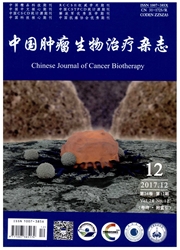

 中文摘要:
中文摘要:
目的:通过建立辐射致癌的细胞模型,应用蛋白质组学技术观察辐射癌变细胞和正常细胞间的差异蛋白表达谱,以期获得辐射致癌相关蛋白。方法:选取永生化的人支气管上皮细胞株(BEAS-2B),利用γ射线照射诱导癌变,建立辐射致癌的细胞模型。应用二维凝胶电泳技术,筛选癌变细胞和正常细胞间的差异表达蛋白点并进行质谱鉴定分析。通过实时荧光定量PCR和Western blotting技术对其中4个蛋白(ENO1、PrxⅠ、Dyrk2和GPX1)在辐射致癌不同阶段的表达情况进行分析。结果:在辐射癌变细胞和正常细胞间共得到差异表达蛋白点59个,其中14个点仅在癌变细胞中表达,15个点仅在正常细胞中表达,23个点在癌变细胞中表达降低,7个点在癌变细胞中表达升高。通过质谱分析,共有26个蛋白质点得到鉴定,主要包括一些参与细胞代谢、增殖、分化的酶类、信号调控蛋白、DNA结合蛋白以及一些细胞结构蛋白、少数功能不明的蛋白及肽段,其中ENO1和PrxⅠ随辐射癌变的进展而升高,Dyrk2和GPX1随辐射癌变的进展而降低。结论:应用二维电泳技术获得了辐射致癌差异表达蛋白谱,筛选和鉴定了与辐射致癌相关的差异表达蛋白,并分析部分差异蛋白在辐射致癌不同阶段的表达情况。研究结果为阐明辐射致癌机制提供了实验依据。
 英文摘要:
英文摘要:
Objective: To establish a cell model of radiation-induced carcinogenesis and to observe the different protein profile between radiation-induced cancer cells and normal cells by proteomic method, so as to obtain proteins associated to radiation-induced carcinogenesis. Methods:Immortalized human bronchial epithelial cell line BEAS-2B was radiated with γ ray to established radiation-induced carcinogenesis cell model. Two-dimensional (2D) electrophoresis was employed to identify the altered protein profile between radiation-induced cancer cells (BR22P50) and normal cells (BNP50). The differentially expressed proteins were identified by mass spectrometry; the expression of 4 differentially expressed proteins ( ENO1, Prx Ⅰ, Dyrk2 and GPX1 ) was analyzed by fluorescent RT-PCR and Western blotting at different phases of carcinogenesis. Results: Totally 59 protein spots were found to be differentially expressed between BR22 Ps0 and BNP50 cells, with 14 only expressed in BR22P50 cells, 15 only expressed in BNP50. For the other 30 spots, 7 spots were highly expressed and 23 spots were lowly expressed in BR22P50 cells. Using MALDI-TOF MS technology, 26 spots were identified by PMF, including enzymes, structure proteins, cell signal proteins, binding proteins, metabolism related proteins, some unknown function proteins and ploy-peptides. RT-PCR and Western blotting showed that expression of ENO1 and Prx Ⅰ were increased and of Dyrk2 and GPX1 were decreased with the advancement of radiation carcinogenesis. Conclusion:2D electrophoresis is effective in identifying the protein expression profiles between BR22P50 and BNP50 cells. Some differentially expressed proteins have been analyzed during the development of radiation carcinogenesis. This study may provide a novel clue to probe the mechanism of radiation carcinogenesis.
 同期刊论文项目
同期刊论文项目
 同项目期刊论文
同项目期刊论文
 期刊信息
期刊信息
